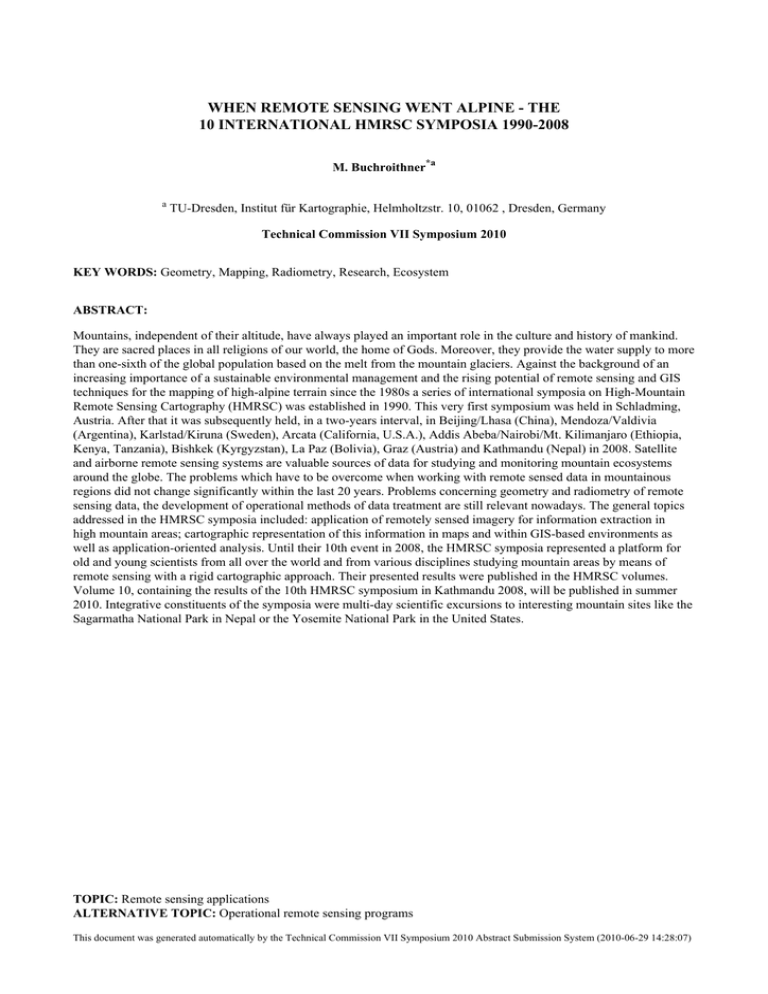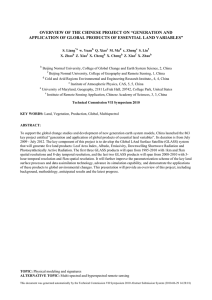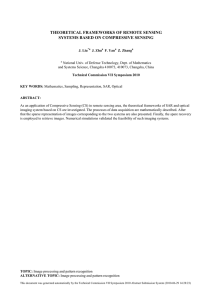WHEN REMOTE SENSING WENT ALPINE - THE
advertisement

WHEN REMOTE SENSING WENT ALPINE - THE 10 INTERNATIONAL HMRSC SYMPOSIA 1990-2008 M. Buchroithner*a a TU-Dresden, Institut für Kartographie, Helmholtzstr. 10, 01062 , Dresden, Germany Technical Commission VII Symposium 2010 KEY WORDS: Geometry, Mapping, Radiometry, Research, Ecosystem ABSTRACT: Mountains, independent of their altitude, have always played an important role in the culture and history of mankind. They are sacred places in all religions of our world, the home of Gods. Moreover, they provide the water supply to more than one-sixth of the global population based on the melt from the mountain glaciers. Against the background of an increasing importance of a sustainable environmental management and the rising potential of remote sensing and GIS techniques for the mapping of high-alpine terrain since the 1980s a series of international symposia on High-Mountain Remote Sensing Cartography (HMRSC) was established in 1990. This very first symposium was held in Schladming, Austria. After that it was subsequently held, in a two-years interval, in Beijing/Lhasa (China), Mendoza/Valdivia (Argentina), Karlstad/Kiruna (Sweden), Arcata (California, U.S.A.), Addis Abeba/Nairobi/Mt. Kilimanjaro (Ethiopia, Kenya, Tanzania), Bishkek (Kyrgyzstan), La Paz (Bolivia), Graz (Austria) and Kathmandu (Nepal) in 2008. Satellite and airborne remote sensing systems are valuable sources of data for studying and monitoring mountain ecosystems around the globe. The problems which have to be overcome when working with remote sensed data in mountainous regions did not change significantly within the last 20 years. Problems concerning geometry and radiometry of remote sensing data, the development of operational methods of data treatment are still relevant nowadays. The general topics addressed in the HMRSC symposia included: application of remotely sensed imagery for information extraction in high mountain areas; cartographic representation of this information in maps and within GIS-based environments as well as application-oriented analysis. Until their 10th event in 2008, the HMRSC symposia represented a platform for old and young scientists from all over the world and from various disciplines studying mountain areas by means of remote sensing with a rigid cartographic approach. Their presented results were published in the HMRSC volumes. Volume 10, containing the results of the 10th HMRSC symposium in Kathmandu 2008, will be published in summer 2010. Integrative constituents of the symposia were multi-day scientific excursions to interesting mountain sites like the Sagarmatha National Park in Nepal or the Yosemite National Park in the United States. TOPIC: Remote sensing applications ALTERNATIVE TOPIC: Operational remote sensing programs This document was generated automatically by the Technical Commission VII Symposium 2010 Abstract Submission System (2010-06-29 14:28:07)



